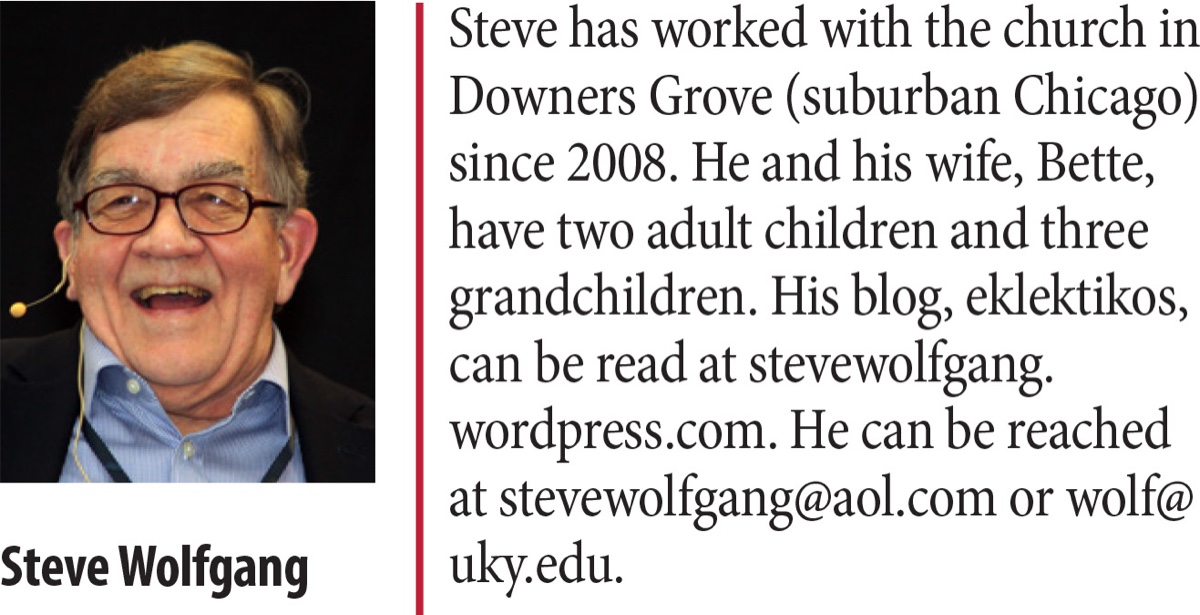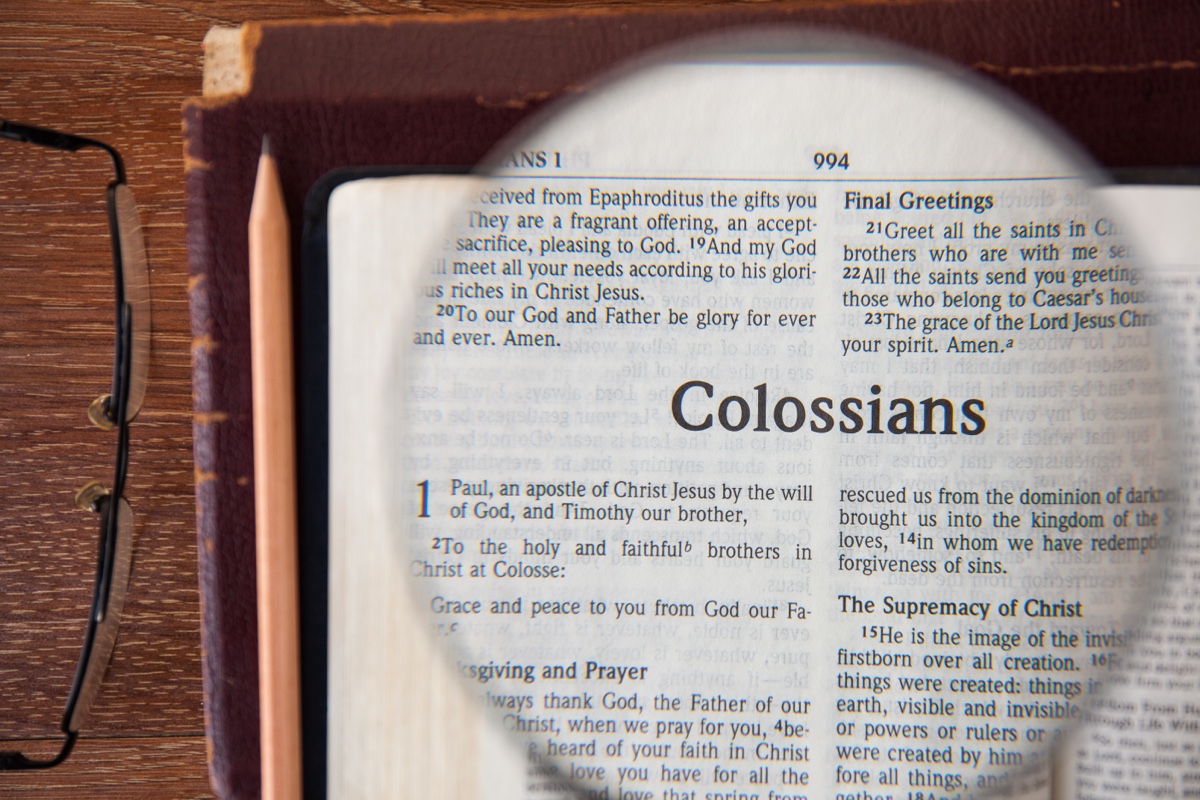By Steve Wolfgang
Synopsis: Colossians often “lives in the shadow” of Ephesians, written to a church in a better-known city. Yet Colossians contains many insights and topics well worth studying in its own right.
How would you react if the church where you worship received a letter from a preacher who has never been to the city where you live, and never attended the congregation where you worship? What if this letter dares to criticize the behavior and teaching of some who have become part of the congregation?
Now, what if the letter is from a respected apostle of Jesus Christ, inspired by the Holy Spirit Himself? What if it contained not only warnings about false teachings and behaviors advocated by other Christians, but encouragement to grow in our walk as Christians, and practical advice on family relationships and other concerns? What if the false ideas it exposes are spreading to other places and adversely affecting the spiritual growth of other Christians?
Colossians contains many themes and topics similar to those in Ephesians, and often “lives in the shadow” of that better-known epistle to a church in a more prominent city. Yet, as with any portion of God’s revelation to man, it is well worth studying in its own right. This issue unpacks some of the many aspects of this fascinating letter!
Some questions that may occur when first encountering Colossians might be: Where is Colossae situated? Who were the Colossians? Who wrote this epistle? Who were his audience? What were “the problems” at Colossae? What warning about potential crises does it contain? What spiritual opponents does it identify (if any)? What strategies regarding spiritual warfare? What spirals of spiritual growth, and regulations of personal situations and relationships, does the letter enjoin? How can it spur us to greater devotion and service to King Jesus, conqueror of “the powers,” Lord of heaven and earth? Several of these issues are addressed in the following articles. Read on!
“Colossians, like many books, and for that matter, like most symphonies, plays or poems, is not the sort of work that can be simply split up into successive units, like the separate inches marked on a ruler. . . It is more like a flower, growing from a small bud to a large bud and then gradually opening up to reveal, layer upon layer, the petals that had all along been hidden inside.”1
Colossae is situated in the fertile Lycus Valley, near Laodicea and Hierapolis. “The site is now almost completely bare and has not been excavated. . . It covers twenty-three acres [and] rises nearly 200 feet above the plain, witnessing to a longevity that stamped it as one of the premier cities of southwest Phrygia.”2 Notably, “the whole area suffered a calamity in the first century AD. Somewhere between AD 60 and 64 an earthquake struck the area and, according to Tacitus (Annals, 14.27), overthrew Laodicea. It may be assumed that nearby Colossae and Hierapolis were also affected. Tacitus goes on to say that Laodicea recovered herself with no material help from Rome, and no doubt Colossae did the same.”3 Though commercially less successful, Colossae continued to be a place of importance in the Roman imperial period, as is shown by an inscription of this time, and by the minting of its own coins from the second and third century AD that depict the usual city officials, showing that it had the rights of a city under the Romans.
Texts such as Acts 14:19-20 and 2 Timothy 3:11 relate the opposition to the gospel suffered by Paul and his companions. “Indeed, the pursuit by Paul’s Jewish opponents from Pisidian Antioch and Iconium to Lystra may indicate the ease of access between these cities on the Via Sebaste. At Lystra they stoned Paul and left him for dead, but he survived and set off with Barnabas to Derbe.”4 Furthermore, the collection of the temple tax (cf. Matt. 17:24) “implies a fairly regular communication between the cities of the Lycus valley and the land of Israel. These would no doubt be facilitated by the good system of roads. . . which would probably bring a steady stream of Jewish travelers through a region where there were so many Jews resident. In the same connection, we should note that residents of Asia and Phrygia are reported among the crowd gathered in Jerusalem on the day of Pentecost in Acts 2:9-10.”5
While Paul could have visited the area when he went “throughout the region of Galatia and Phrygia” (Acts 18:23), there is no evidence that he preached in Colossae; the gospel could have been pioneered there by the converts of his preaching at Antioch in Pisidia (Acts 13:13-51) or by Christians in Ephesus when “all the residents of Asia heard the word of the Lord, both Jews and Greeks” (Acts 19:10).
The belief that Colossians is pseudepigraphal (written by a follower of Paul’s in his name after his death), is alleged by some modern scholars. “Raymond Brown estimates that 60 percent of current scholars think that Paul did not write Colossians. Yet this view of the authorship of the letter is relatively recent. No early Christian doubted Paul’s authorship” and it was accepted as Scripture without apparent controversy. Yet, in the nineteenth century, the rise of historical criticism led to challenges of many traditionally accepted views of Scripture.6
Indeed, “There is no shred of evidence that the Pauline authorship of the whole or any part of this epistle was ever disputed until the nineteenth century. It formed part of the Pauline corpus as far back as can be traced, and evidence of such a character cannot lightly be swept aside. This strong external attestation is further supported by the close link between the epistle and Philemon, whose authenticity has been challenged by only the most extreme negative critics.”7
In 2014, I was asked to write about “New Testament Documents: Date and Authorship” for Expository Files. Here’s what I said about Colossians:
A common argument is that there is a relatively large number of words (48) which appear in Colossians but are found nowhere else in Paul’s writings (33 of which are not found in the other New Testament documents). But the number of these hapax legomena (words used only once, and not found elsewhere in the New Testament) are no greater in Colossians than in other undisputed Pauline epistles (Galatians, for example, has 35 such hapax legomena in an undisputed epistle of similar length).
Furthermore, since those who claim that Colossians is “non-Pauline” often cannot agree among themselves, “reading and considering the arguments of some academic challengers can leave a distinct impression that any such objection, like proverbial beauty, is very much in the eye of the beholder.”8 Such ‘stylistic’ objections conveniently ignore the fact that the Colossian epistle does, in point of fact, contain indisputably Pauline stylistic characteristics, found nowhere else in non-Pauline documents.
“Thus we are faced with an interesting conundrum that shows how difficult it is to draw neat lines around authors and their thought. Scholars are notoriously unwilling to admit ignorance or indecision [the Latin for ‘we do not know’ is ‘ignoramus’!]”9 For a recent analysis of authorship issues, see which includes the following observation: “More precise studies in stylometrics” have demonstrated that “numerous past studies have committed the fallacy of ‘statisticulating,’ which is ‘engaging in the unprincipled and statistically unjustified use of numbers to support a particular point.’”10
Many of the fascinating aspects of this apostolic letter are discussed in the following articles, including the spiral of spiritual growth (1:9-12); a “Christ-hymn” (1:20); the relationship of baptism and the concept of covenant (2:12); as well as practical instructions for Christians, including family relationships in the last portion of the epistle. A particularly problematic issue addressing false teachings arising from early gnostic ideology and residual concepts from various forms of Judaism are particularly addressed in Colossians 2:8-23.
Nathan Ward and Jeff Smelser provide insights into the issues raised by “the Colossian heresy,” and Lauren Bassford provides insight into ways Christian women can learn from Colossians. Andrew Dow, BJ Sipe, and Bruce Reeves examine various topics from several of the chapters in Colossians. It has been a pleasure and privilege to work with these authors, and I am certain you will profit from their work. Read on—a spiritual fest awaits you!
N.T.Wright, Colossians (Tyndale NTC, 1986), p. 22. A useful survey of the varying approaches to the structure of Colossians, comparing the outlines from other popular commentaries, is in Scot McKnight’s commentary (NICNT, 2018, 66-72). Readers should also consult Walton Weaver, Colossians (Truth Commentaries, 1996).↩︎
Alan H. Cadwallader, “The Social and Geographical World of Colossae,” (Lexham Geographic Commentary, 2019), 569-570.↩︎
Harold Mare, “Archeological Prospects at Colossae,” Near East Archaeological Society Bulletin 7 (1976): 42-43.↩︎
Anson F. Rainey and R. Steven Notley, The Sacred Bridge: Carta’s Atlas of the Biblical World (2nd ed.; Jerusalem, 2014), 373.↩︎
James D.G. Dunn, Colossians (NIGCT, 1996), p. 22.↩︎
Douglas Moo, Colossians (PNTC, 2008), pp. 29-30↩︎
Donald Guthrie, New Testament Introduction (4th rev. ed., 1996), 576.↩︎
Steve Wolfgang, “New Testament Documents: Date and Authorship.” In Warren Berkley and Jon Quinn, eds. The Integrity of the New Testament (Expository Files, 2014), 77-94.↩︎
John M.G. Barclay, Colossians and Philemon (London: T&T Clark, 2001), 35.↩︎
Gregory K. Beale, “The Problem of Using the Criteria of Vocabulary and Writing Style to Discern Purportedly Non-Pauline Letters” in Colossians and Philemon, (Baker, 2019), 439-443.↩︎


